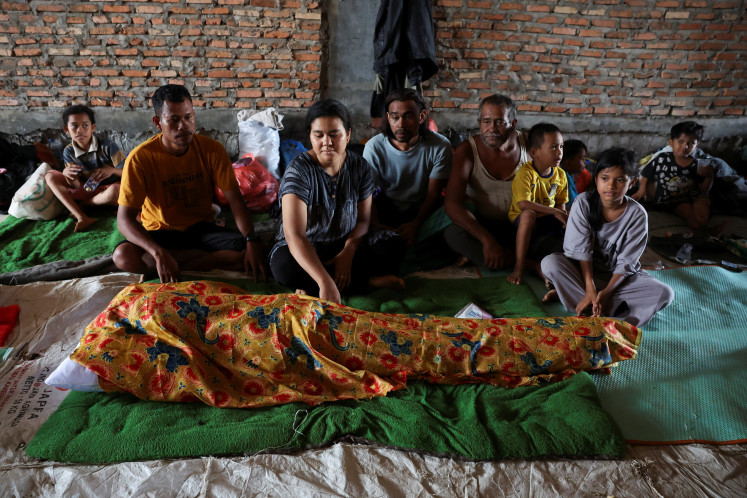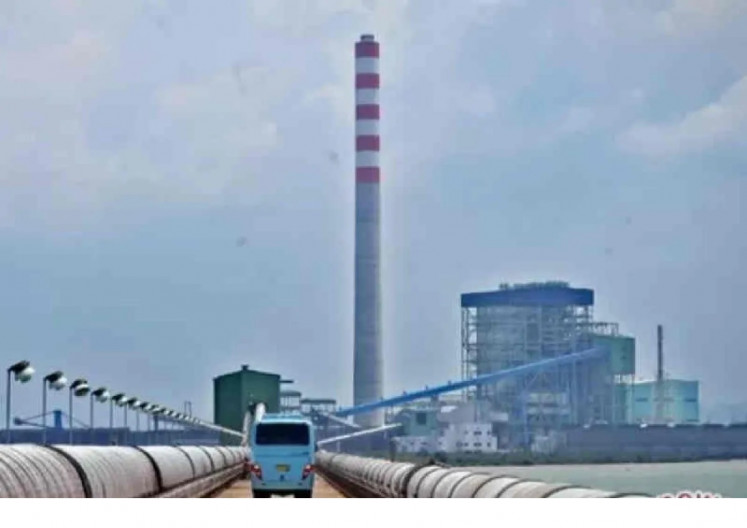Popular Reads
Top Results
Can't find what you're looking for?
View all search resultsPopular Reads
Top Results
Can't find what you're looking for?
View all search resultsCecep Kusmana: Growing mangroves at sea
JP/THERESA SUFIA I’m obsessed with the idea of growing mangroves offshore as it seems impossible to have them onshore due to land scarcity, says Cecep Kusmana
Change text size
Gift Premium Articles
to Anyone
JP/THERESA SUFIA
I’m obsessed with the idea of growing mangroves offshore as it seems impossible to have them onshore due to land scarcity, says Cecep Kusmana.
Cecep Kusmana, commonly called Prof. Cecep by students of the Bogor Institute of Agriculture (IPB), is an ecologist and mangrove silviculturist who invented the technique of guludan, where mangroves are grown in 2- to 3-meter deep pools.
Guludan is a body of water embanked with bamboo stems and filled with earth sacks, on which soil is poured in bulk as a medium to grow mangrove seedlings.
About 4 meters wide and 6 meters long, it can contain up to 242 seedlings.
The graduate of Kyoto University, Japan, born on February 12, 1961, is head of the Forest Ecology Department, School of Forestry, IPB, besides lecturing at the institute.
Research on this method was conducted in 1996, and in 1997-1998, the Jakarta Forestry Office — in cooperation with the IPB School of Forestry — sought the best solution to restore the coastal area of Muara Angke Kapuk as a mangrove forest zone, after the administration failed several failed times to do so.
“During 1997-1998, we studied the mangrove species in Muara Angke Kapuk, Sedyatmo Toll Road, and Ekowisata Mangrove Park,” said Cecep.
In 1999, the research continued, finding that the presence of mangroves along the coast of Muara Angke Kapuk could prevent incoming tidal waves, thus reducing their tidal energy upon passing mangrove stems. Later the researchers began conducting mangrove rehabilitation on both sides of Sedyatmo Toll Road.
“Our studies show that the Jakarta regional government was enthusiastic about restoring ponds along the sides of Sedyatmo and in Ekowisata Mangrove Park. In 2004, we also made a habitat survey particularly in ponds in these areas,” Cecep went on.
However, it was difficult to rehabilitate the ponds due to their 2-3-meter depth while the pond surface was lower than sea-level as a result of land subsidence, causing permanent submerging in tidal water so that mangrove seedlings failed to grow. Finally, the pond mangrove planting applied Cecep’s guludan method and the seedlings grew well.
Beginning in 2005, guludan was developed on a larger scale and used by private and state enterprises, including PT. Jasa Marga (state road building company), Bank Mandiri, dan PT. Pertamina (state oil company), for mangrove replanting from Sedyatmo, Ekowisata Mangrove Park, to Muara Angke Kapuk, forming Jakarta’s Green Belt zone.
The guludan technique however is fairly expensive. A single guludan capable of nursing 242 mangrove seedlings costs around Rp 10 million (US$1,000).
“The Maritime and Agriculture Office helped me develop the guludan method for coastal areas degraded by deep inundation. I also received a research grant from the Directorate General of Higher Education at the National Education Ministry,” he said.
Mangroves play a crucial role protecting shorelines against strong waves and storms while also preventing seawater intrusion. Ideally they should be grown along 2 kilometers of Jakarta’s shoreline. Such intrusion in Jakarta requires not only mangroves but urban forests to deal with it besides decreased use of underground water.
Owing to the costly and time-consuming rehabilitation of mangrove forests, all regional administrations especially Jakarta should be strict and conduct profound studies before making decisions, to avoid easy licensing of construction projects. Any licensing mistake can harm future generations.
“So my obsession is to grow mangroves offshore as we have the technology and human resources, while there isn’t much land left onshore. Our only constraint is the lack of funds.”
The IPB professor added she was convinced that planting mangroves at sea would succeed because it had been done previously in the coastal area of Pantai Indah Kapuk (PIK) by means of guludan 100 meters offshore, after building a breakwater.
Asked why the method he invented had not yet been registered with the patent office, Cecep replied, “Actually I don’t want to have it patented because I am happy if the technique is applied by many people. But with the encouragement from colleagues, I’m going to apply for its patent shortly.
“If any private- or state-owned company intends to use guludan for mangrove planting, I will allow it without imposing fees.”
His humble attitude was also apparent from his readiness to give free lectures to a student from Tanzania, Africa.
“A Tanzanian student expressed his interest in studying mangrove planting but he had no scholarship. I promised him free lectures and research activities as long as he could support his own expenses.
However, it is a pity that he cannot afford to join us. A Dutch student showed the same interest a few months ago and he will come here soon,” he concluded.










